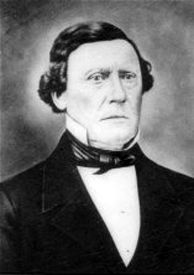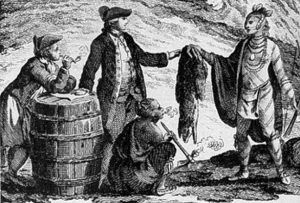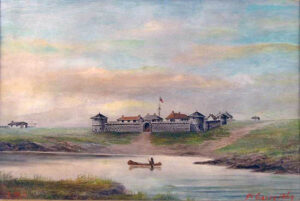Fur trader Daniel Lamont was one of three partners of the Upper Missouri Outfit of the American Fur Company and one of the original company men of the Columbia Fur Company.
Lamont was born to Colin Lamont Sr. and Jane Smith Lamont in Greenock, Scotland, on April 10, 1798.
Somewhere along the line, he went to Canada and worked in Lord Selkirk’s Red River Colony. However, in about January 1817, he returned home to Scotland on a Hudson’s Bay Company ship. He was back on the Red River in 1820, trading for the Hudson’s Bay Company.
During these years, there was constant turmoil at the Red River colony as the large trading companies battled for control. Hudson’s Bay Company absorbed the British Northwest Company in 1821. The same year, the British government forced the rivaling Hudson’s Bay Company and North West Company to merge.
With the prospect of unemployment looming, several traders, including Kenneth McKenzie, William Laidlaw, Honore Picotte, Thomas Jeffries, James Kipp, Daniel Lamont, Joseph Renville, and American William Tilton, traveled to St. Louis, Missouri, and entered into the American fur trade in November 1821. On July 17, 1822, William Tilton and S.S. Dudley secured a trading license from Indian Superintendant William Clark at St Louis to trade with the Sioux on the Minnesota River and the Mandan and others on the Missouri River.
These men, along with others, soon formed the Columbia Fur Company and began fur trading and Indian trading in Michigan Territory and the unorganized territory of the United States between the upper Mississippi and the upper Missouri Rivers.
Made up of experienced fur traders, they made impressive profits and soon set up a series of trading posts along the Missouri River. Its headquarters were at Fort Tecumseh, which was first established in 1822 in central South Dakota. Named after Shawnee Indian Chief Tecumseh, it was located about one mile north of the mouth of the Bad River.
In June 1822, Lamont filed his intention to become a United States citizen. Sometime before 1824, he married Hushes the Night, the daughter of Cloud Man, a Dakota Sioux Chief in Minnesota. The couple would have a daughter named Jane.
In 1826 he worked at Fort Factory at the mouth of the Minnesota River.

Kenneth McKenzie
In 1827, while Joseph Renville was President of the Columbia Fur Company, it merged with the American Fur Company. Kenneth McKenzie was then placed in control of the American Fur Company’s interests in the upper Missouri River. He formed the Upper Missouri Outfit subdivision with William Laidlaw and Daniel Lamont. As a general agent for the Upper Missouri Outfit, McKenzie soon established his headquarters at a new post at the mouth of the Yellowstone River, which became known as Fort Union, North Dakota.
In July 1831, Lamont married Margaret Wilson in St. Louis, Missouri. The following year, he was working at Fort Tecumseh, South Dakota.
In 1834, John Jacob Astor sold the Western Department of the American Fur Company to Pratte, Chouteau & Co. and reorganized the Upper Missouri Outfit. Chouteau began to break up the Upper Missouri Outfit in 1835 with the creation of the Sioux Outfit. Chouteau named Honore Picotte to head the new department headquartered out of Fort Pierre Chouteau, South Dakota. Unhappy with this arrangement, Laidlaw and Lamont sold their shares and left the upper Missouri River for St. Louis, Missouri.
Daniel Lamont went into business with Peter and Joseph Powell in the firm of Powell, Lamont, and Company, wholesalers in dry goods in the Arkansas Valley and Santa Fe market. William Laidlaw soon joined him, and the company enlarged its market and began dealing in buffalo and beaver from the upper Arkansas River and Santa Fe.
Daniel Lamont died in Minnesota Territory in 1838. Afterward, Laidlaw left the Powell, Lamont, and Company but remained in the upper Missouri fur trade until 1844, when he retired to his home at Liberty, Missouri, where he lived out his days with his Sioux Indian wife MaryAnn, until his death on October 9, 1852.
By Kathy Alexander/Legends of America, updated November 2022.
Also See:


